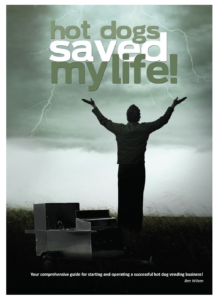Pergi ke luar talian dengan aplikasi Player FM !
How a Hot Dog Stand Saved My Life with Ben Wilson
Manage episode 439794583 series 1539985
Ben Wilson, the man behind LearnHotDogs.com, is known for his no-nonsense approach to entrepreneurship through street food vending. His hot dog cart story isn’t just about slinging dogs—it’s about survival. “It saved my life, literally,” Wilson says. His book, How Hot Dog Carts Saved My Life, details his personal rise from financial hardship to entrepreneurial success, showing that the humble hot dog cart can be a lifeline as much as a business venture.
The book is equal parts memoir and how-to guide, offering readers practical advice from someone who’s been there and done that. Wilson didn’t stumble into vending with a roadmap. His early mistakes—misunderstanding local codes, using the wrong equipment—taught him lessons that he now shares with others. “I want you to succeed,” he writes, “and I’m going to watch you succeed.” His philosophy? If you’re willing to learn, a hot dog cart can turn into more than just a paycheck; it can change your life.

Ben Wilson
Eventually, Ben decided to get into the hot dog concession business and purchased his first cart. Fast forward two months and Ben’s business had expanded to three carts and he was well on his way toward operating his second successful business. In addition to learning Ben’s story, you’ll also learn what to expect in the hot dog business on the podcast.
Breaking Down the Profit Potential
Wilson’s LearnHotDogs.com emphasizes that street food vending, especially with a hot dog cart, can be surprisingly lucrative if you know the game. According to Wilson, a basic hot dog cart can sell anywhere from 100 to 200 hot dogs on a busy day. Let’s break that down.
- Cost of goods: A hot dog (including bun, condiments, etc.) might cost you around $3.
- Sale price: On average, vendors charge $7 to $8 per hot dog.
- Daily profit potential: If you sell 150 hot dogs at $8.00, that’s $1,200 in revenue. Subtracting $450 for your cost of goods, you’re left with $750 in gross profit for one day of work.
Of course, vending comes with its challenges—location scouting, permits, and weather fluctuations. But Wilson stresses that the business can scale. Add catering gigs or special events, and those numbers can climb fast. Vendors who invest in more elaborate carts or offer specialized menus (like gourmet sausages) can see even higher margins. Wilson has also seen successful vendors who branch into additional streams, such as private events or seasonal festivals, boosting their overall take.

Ben Wilson’s book “How Hot Dogs Saved My Life” is available on Amazon.
For many, a hot dog cart isn’t just an entry-level gig. Wilson believes it’s a stepping stone toward full financial freedom, especially for those who’ve felt shut out from traditional business paths. As Ben explains, “There’s nothing between you and success except air and opportunity.”
I apologize, but there are few minor technical blips within the podcast. Hopefully there’s nothing major that would prevent anyone from listening. In the future, I’ll be continually improving the audio quality and format of the show.
Why Hot Dog Carts Are Low-Risk
Ben Wilson’s rise in the world of street food vending through his platform LearnHotDogs.com shows just how accessible the hot dog cart business can be for budding entrepreneurs. One of the key reasons behind its success is that hot dog vending is a low-risk business model with several built-in advantages.
First, the initial investment is relatively modest compared to other food ventures. Wilson himself talks about starting with a basic cart, which typically costs anywhere between $2,000 to $5,000. “The upfront cost is low, and the risks are manageable,” he says. This is a far cry from the six-figure investment required for a brick-and-mortar restaurant or even a fully equipped food truck. The low cost of entry makes it an attractive option for anyone looking to dip their toes into the food business without taking on massive debt.

Ben Wilson showing off his cart.
Another reason hot dog carts are low risk? They’re mobile. If you pick a bad location, you’re not stuck. “You can roll your business to where the customers are,” Wilson explains, and this mobility gives you the flexibility to test different markets without the long-term commitment of a lease or mortgage.
Advantages of Hot Dog Vending
Wilson highlights several key advantages of vending. First, you don’t need to be a gourmet chef to succeed. The product is simple, the preparation is easy, and the customer demand is steady. Hot dogs are a universally loved food with low preparation costs and high profit margins, especially when paired with sides like chips or drinks.
Another advantage is that hot dog carts allow for direct customer interaction. This personal touch builds regulars. “People come back for more than the hot dog—they come back for the experience,” Wilson says. Being at the cart, engaging with customers, and providing a memorable interaction turns you into a local fixture, which helps boost both your sales and your reputation.
Hot dog carts also offer flexibility in scheduling. Vendors can set their own hours, work events on weekends, or cater private parties. This flexibility, combined with the low operational costs, makes hot dog vending an ideal side hustle or full-time gig.
Growing and Expanding a Hot Dog Business
Once you’ve mastered the basics, Wilson believes there’s plenty of room for expansion. One method is to diversify your menu. While the core of the business is the classic hot dog, you can add gourmet sausages, specialty toppings, or even vegan options to cater to a broader audience. This not only attracts new customers but also boosts your average sale price.
Another expansion strategy is to take on larger events or catering gigs, which can drastically increase your revenue. “Catering gigs are where the money’s at,” Wilson says. At weddings, private parties, or corporate events, you can charge premium prices—often $10 or more per hot dog—while serving a captive audience. With these kinds of events, it’s possible to make $1,000 in a single day.
For those ready to take it a step further, Wilson suggests buying more carts and hiring staff to operate them in different locations. “It’s not unheard of for vendors to expand to multiple carts and turn it into a real operation,” Wilson notes. By scaling up, you can go from a one-cart owner to running a small fleet, turning the business into a significant income stream.
In the end, Wilson’s philosophy is simple: “Start small, think big, and always be ready to pivot.” With the right hustle and strategy, the hot dog cart business can be more than just a way to make a living—it can be the beginning of something much bigger.
What You’ll Learn in this Episode:
- Why hot dog carts are a low-risk business model.
- Advantages of hot dog vending.
- How to grow and expand a hot dog business.
- How much money you could potentially make with a hot dog cart.
Mentioned During the Show
LearnHotDogs.com – Ben’s hot dog vending training site. All the blog posts, videos, and podcasts you would ever need to build this type of concession business.
Hot Dogs Saved My Life Book – Ben’s book referenced during the podcast.
If you enjoyed this episode, please share this post with your friends on Facebook and X. I truly appreciate any help you can provide in spreading the word about the Food Truck Empire Podcast. I plan to publish a new podcast episode each Friday and hope you’ll make this podcast a weekly tradition. You can also check us out on iTunes.
The post How a Hot Dog Stand Saved My Life with Ben Wilson appeared first on Food Truck Empire.
14 episod
Manage episode 439794583 series 1539985
Ben Wilson, the man behind LearnHotDogs.com, is known for his no-nonsense approach to entrepreneurship through street food vending. His hot dog cart story isn’t just about slinging dogs—it’s about survival. “It saved my life, literally,” Wilson says. His book, How Hot Dog Carts Saved My Life, details his personal rise from financial hardship to entrepreneurial success, showing that the humble hot dog cart can be a lifeline as much as a business venture.
The book is equal parts memoir and how-to guide, offering readers practical advice from someone who’s been there and done that. Wilson didn’t stumble into vending with a roadmap. His early mistakes—misunderstanding local codes, using the wrong equipment—taught him lessons that he now shares with others. “I want you to succeed,” he writes, “and I’m going to watch you succeed.” His philosophy? If you’re willing to learn, a hot dog cart can turn into more than just a paycheck; it can change your life.

Ben Wilson
Eventually, Ben decided to get into the hot dog concession business and purchased his first cart. Fast forward two months and Ben’s business had expanded to three carts and he was well on his way toward operating his second successful business. In addition to learning Ben’s story, you’ll also learn what to expect in the hot dog business on the podcast.
Breaking Down the Profit Potential
Wilson’s LearnHotDogs.com emphasizes that street food vending, especially with a hot dog cart, can be surprisingly lucrative if you know the game. According to Wilson, a basic hot dog cart can sell anywhere from 100 to 200 hot dogs on a busy day. Let’s break that down.
- Cost of goods: A hot dog (including bun, condiments, etc.) might cost you around $3.
- Sale price: On average, vendors charge $7 to $8 per hot dog.
- Daily profit potential: If you sell 150 hot dogs at $8.00, that’s $1,200 in revenue. Subtracting $450 for your cost of goods, you’re left with $750 in gross profit for one day of work.
Of course, vending comes with its challenges—location scouting, permits, and weather fluctuations. But Wilson stresses that the business can scale. Add catering gigs or special events, and those numbers can climb fast. Vendors who invest in more elaborate carts or offer specialized menus (like gourmet sausages) can see even higher margins. Wilson has also seen successful vendors who branch into additional streams, such as private events or seasonal festivals, boosting their overall take.

Ben Wilson’s book “How Hot Dogs Saved My Life” is available on Amazon.
For many, a hot dog cart isn’t just an entry-level gig. Wilson believes it’s a stepping stone toward full financial freedom, especially for those who’ve felt shut out from traditional business paths. As Ben explains, “There’s nothing between you and success except air and opportunity.”
I apologize, but there are few minor technical blips within the podcast. Hopefully there’s nothing major that would prevent anyone from listening. In the future, I’ll be continually improving the audio quality and format of the show.
Why Hot Dog Carts Are Low-Risk
Ben Wilson’s rise in the world of street food vending through his platform LearnHotDogs.com shows just how accessible the hot dog cart business can be for budding entrepreneurs. One of the key reasons behind its success is that hot dog vending is a low-risk business model with several built-in advantages.
First, the initial investment is relatively modest compared to other food ventures. Wilson himself talks about starting with a basic cart, which typically costs anywhere between $2,000 to $5,000. “The upfront cost is low, and the risks are manageable,” he says. This is a far cry from the six-figure investment required for a brick-and-mortar restaurant or even a fully equipped food truck. The low cost of entry makes it an attractive option for anyone looking to dip their toes into the food business without taking on massive debt.

Ben Wilson showing off his cart.
Another reason hot dog carts are low risk? They’re mobile. If you pick a bad location, you’re not stuck. “You can roll your business to where the customers are,” Wilson explains, and this mobility gives you the flexibility to test different markets without the long-term commitment of a lease or mortgage.
Advantages of Hot Dog Vending
Wilson highlights several key advantages of vending. First, you don’t need to be a gourmet chef to succeed. The product is simple, the preparation is easy, and the customer demand is steady. Hot dogs are a universally loved food with low preparation costs and high profit margins, especially when paired with sides like chips or drinks.
Another advantage is that hot dog carts allow for direct customer interaction. This personal touch builds regulars. “People come back for more than the hot dog—they come back for the experience,” Wilson says. Being at the cart, engaging with customers, and providing a memorable interaction turns you into a local fixture, which helps boost both your sales and your reputation.
Hot dog carts also offer flexibility in scheduling. Vendors can set their own hours, work events on weekends, or cater private parties. This flexibility, combined with the low operational costs, makes hot dog vending an ideal side hustle or full-time gig.
Growing and Expanding a Hot Dog Business
Once you’ve mastered the basics, Wilson believes there’s plenty of room for expansion. One method is to diversify your menu. While the core of the business is the classic hot dog, you can add gourmet sausages, specialty toppings, or even vegan options to cater to a broader audience. This not only attracts new customers but also boosts your average sale price.
Another expansion strategy is to take on larger events or catering gigs, which can drastically increase your revenue. “Catering gigs are where the money’s at,” Wilson says. At weddings, private parties, or corporate events, you can charge premium prices—often $10 or more per hot dog—while serving a captive audience. With these kinds of events, it’s possible to make $1,000 in a single day.
For those ready to take it a step further, Wilson suggests buying more carts and hiring staff to operate them in different locations. “It’s not unheard of for vendors to expand to multiple carts and turn it into a real operation,” Wilson notes. By scaling up, you can go from a one-cart owner to running a small fleet, turning the business into a significant income stream.
In the end, Wilson’s philosophy is simple: “Start small, think big, and always be ready to pivot.” With the right hustle and strategy, the hot dog cart business can be more than just a way to make a living—it can be the beginning of something much bigger.
What You’ll Learn in this Episode:
- Why hot dog carts are a low-risk business model.
- Advantages of hot dog vending.
- How to grow and expand a hot dog business.
- How much money you could potentially make with a hot dog cart.
Mentioned During the Show
LearnHotDogs.com – Ben’s hot dog vending training site. All the blog posts, videos, and podcasts you would ever need to build this type of concession business.
Hot Dogs Saved My Life Book – Ben’s book referenced during the podcast.
If you enjoyed this episode, please share this post with your friends on Facebook and X. I truly appreciate any help you can provide in spreading the word about the Food Truck Empire Podcast. I plan to publish a new podcast episode each Friday and hope you’ll make this podcast a weekly tradition. You can also check us out on iTunes.
The post How a Hot Dog Stand Saved My Life with Ben Wilson appeared first on Food Truck Empire.
14 episod
Semua episod
×1 How To Create a Unique & Profitable Menu for a Food Truck 33:56
1 4 Unique Ways This Food Truck Owner Funded His Business 19:50
1 How to Transform Your Menu Into a Grocery Store Product 34:48
1 How Sameer Siddiqui Started a Pakistani Food Truck 32:55
1 Part-time to Full-time on a Food Truck in Only 12 Months 26:24
1 Food Trucks vs Food Carts: Which One Is Better for You? 19:41
1 How a Hot Dog Stand Saved My Life with Ben Wilson 20:32
1 Serve Faster, Sell More: Speed Tips for Food Truck Owners 36:53
1 Linda Jo Kushner Raised $20,265 for a Food Truck on KickStarter 15:44
1 Never Pay for a Certificate of Insurance for a Food Truck & Other Tips 16:54
Selamat datang ke Player FM
Player FM mengimbas laman-laman web bagi podcast berkualiti tinggi untuk anda nikmati sekarang. Ia merupakan aplikasi podcast terbaik dan berfungsi untuk Android, iPhone, dan web. Daftar untuk melaraskan langganan merentasi peranti.

























